 When the weather turns summery, what could be more refreshing than a Greek salad, French style? It’s been so hot here in Paris recently that I’ve made several. All you need is feta, tomatoes, a cucumber, a red onion, some black olives and a little parsley or mint. Unlike the Greek version, salade grecque is generally served in France without sweet peppers or oregano, and with rosé instead of retsina. Call it an Adriatic of the mind.
When the weather turns summery, what could be more refreshing than a Greek salad, French style? It’s been so hot here in Paris recently that I’ve made several. All you need is feta, tomatoes, a cucumber, a red onion, some black olives and a little parsley or mint. Unlike the Greek version, salade grecque is generally served in France without sweet peppers or oregano, and with rosé instead of retsina. Call it an Adriatic of the mind.
Salade grecque / Greek salad, French style
When researching this post, I got to wondering why this particular combination is known as Greek salad, when there are many salads in Greece, my favorites (other than the above) being taramasalata, known in France simply as tarama, made of salted cod roe, oil and bread, and tzatziki, made of cucumbers, yogurt and garlic. I didn’t find the answer, but I did find quite a bit about one of the main ingredients of salade grecque, the cucumber.
It turns out that cucumbers came to Greece, and then on to the rest of Europe, from the foothills of the Indian Himalayas, where they grow in the wild. One thing that surprised me when I got to France was the shape of cucumbers here — they are smooth and very long, about 16 inches (40 centimeters), quite unlike the shorter, nubbly cucumbers I had encountered in the United States. One can only speculate on why the French prefer the longer variety, which, oddly, is known here as hollandais (Dutch). Suffice it to say that other varieties have begun appearing at Parisian farmer’s markets and grocery stores, including the suddenly popular short cucumber known as libanais (Lebanese).
Cucumbers were enjoyed in ancient Egypt, where they are said to have been popular with the Hebrews brought there as slaves. Le concombre had arrived in France by the Middle Ages, and was favored by Charlemagne, who instructed monasteries to cultivate the fruit (yes, it’s a fruit, not a veggie). By the 17th century it had risen to cult status among the well-heeled, who appreciated the fact that, unlike peasant food, cucumbers were not at all filling and therefore could be considered a pleasure food. According to one French historian of food, cucumbers were even viewed as useful in the art of seduction…
Getting back to the present day, one delightful thing about Greek salad, French style, is that it can be prepared in advance and refrigerated. It stays crisp if you wait to add the vinaigrette until just before serving. This salad can be served as a main dish at lunchtime or as a starter in the evening, followed perhaps by grilled brochettes of lamb or chicken (coming soon), or — if you’d really like to conjure up the seaside — grilled squid with garlic and parsley or Mediterranean-style fish with tapenade.
Other hot-weather suggestions can be found in the Menus section, which I update from time to time according to season. Off the top of my head, summer meals could include: salade niçoise, aïoli (fish and veggies with garlic mayonnaise), assiette de crudités (veggie platter), assiette anglaise (cold roast meat platter), ratatouille, eggplant gratin or cucumber soup. The main idea being to spend less time in the kitchen than at the beach.
Happy summer, and happy cooking.

 Strawberries with basil and balsamic vinegar, aka strawberry carpaccio, appeared relatively recently on Paris bistro menus. The combination makes a refreshing dessert on warm summer evenings — light, tangy and sophisticated. And the real magic is that it takes about five minutes to prepare. You can also vary the ingredients, adding a few raspberries or replacing the basil with mint. Don’t tell your guests about the balsamic — let them guess.
Strawberries with basil and balsamic vinegar, aka strawberry carpaccio, appeared relatively recently on Paris bistro menus. The combination makes a refreshing dessert on warm summer evenings — light, tangy and sophisticated. And the real magic is that it takes about five minutes to prepare. You can also vary the ingredients, adding a few raspberries or replacing the basil with mint. Don’t tell your guests about the balsamic — let them guess.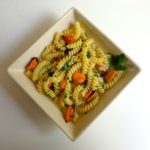 It is surprising, in our globalized world, that we can still travel only a short distance and find ourselves in a whole new foodosphere. I recently had the pleasure of visiting Naples. The first night, at a joint straight out of a Mastroianni-Loren movie, I was served pizza with sausage and friarielli, aka broccoli rabe, which is virtually unfindable in Paris. The last day, I encountered a simple but scrumptious dish of pasta, mussels and pecorino.
It is surprising, in our globalized world, that we can still travel only a short distance and find ourselves in a whole new foodosphere. I recently had the pleasure of visiting Naples. The first night, at a joint straight out of a Mastroianni-Loren movie, I was served pizza with sausage and friarielli, aka broccoli rabe, which is virtually unfindable in Paris. The last day, I encountered a simple but scrumptious dish of pasta, mussels and pecorino. I first encountered this dish a couple of years ago at
I first encountered this dish a couple of years ago at 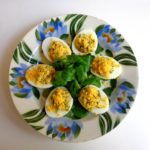 The mimosa tree, its fluffy yellow blossoms a harbinger of spring, has loaned its name not only to a Champagne cocktail but also to the French version of deviled eggs. The eggs are stuffed and topped with of tiny pieces of yolk meant to resemble mimosa flowers. The filling includes parsley or other herbs. It’s a great dish to serve at this time of year — cheery, light and bright. And by the way, it’s also a great way to recycle Easter eggs.
The mimosa tree, its fluffy yellow blossoms a harbinger of spring, has loaned its name not only to a Champagne cocktail but also to the French version of deviled eggs. The eggs are stuffed and topped with of tiny pieces of yolk meant to resemble mimosa flowers. The filling includes parsley or other herbs. It’s a great dish to serve at this time of year — cheery, light and bright. And by the way, it’s also a great way to recycle Easter eggs. If you’d like to kick off festivities with
If you’d like to kick off festivities with 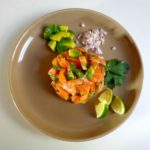 Tomorrow is April Fool’s Day, an event marked in France by pranks known as poissons d’avril, or ‘April fish’. So this seemed an appropriate time to post a fish recipe, all the more so as spring has now sprung with a vengeance in Paris, with warm-weather dishes sprouting on bistro menus like precocious darling buds of May. Salmon tartare is one such dish — light and fresh, its flavor enhanced with avocado, fresh herbs and lime juice.
Tomorrow is April Fool’s Day, an event marked in France by pranks known as poissons d’avril, or ‘April fish’. So this seemed an appropriate time to post a fish recipe, all the more so as spring has now sprung with a vengeance in Paris, with warm-weather dishes sprouting on bistro menus like precocious darling buds of May. Salmon tartare is one such dish — light and fresh, its flavor enhanced with avocado, fresh herbs and lime juice.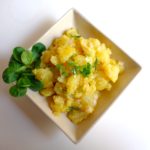 You may say po-TAY-to, I may say po-TAH-to, but the French say “apples of the earth” (pommes de terre), perhaps an indication of their esteem for the humble spud. And French potato salad, simple and earthy, has a taste all its own. Unlike American potato salad, it has no mayonnaise. Unlike the German version, it leaves out the bacon. No, the French bathe potatoes in a vinaigrette while still warm, add chopped shallots and herbs — et voilà.
You may say po-TAY-to, I may say po-TAH-to, but the French say “apples of the earth” (pommes de terre), perhaps an indication of their esteem for the humble spud. And French potato salad, simple and earthy, has a taste all its own. Unlike American potato salad, it has no mayonnaise. Unlike the German version, it leaves out the bacon. No, the French bathe potatoes in a vinaigrette while still warm, add chopped shallots and herbs — et voilà. The wonderful French phrase l’heure de l’apéro means you’re done working and it’s time to kick off your shoes and settle in to a drink as a prelude to a pleasant evening. It’s like cocktail hour, but with a nuance of difference. The drinks are generally not cocktails but variations on wine, and on festive occasions — or even ordinary occasions — amuse-bouches are served with the drinks. For example, lacy chips baked from grated parmesan.
The wonderful French phrase l’heure de l’apéro means you’re done working and it’s time to kick off your shoes and settle in to a drink as a prelude to a pleasant evening. It’s like cocktail hour, but with a nuance of difference. The drinks are generally not cocktails but variations on wine, and on festive occasions — or even ordinary occasions — amuse-bouches are served with the drinks. For example, lacy chips baked from grated parmesan. When is a lamb chop not a lamb chop? It may seem a minor distinction, but here in France a carré d’agneau (rack of lamb) is considered a different dish altogether than côtelettes d’agneau (lamb chops), the difference being that the meat is tender on all sides when the rack is sliced. The elegance makes it a dish for special occasions. Served with a sophisticated purée, for example of parsnips and cumin, it will add a touch of class to your table.
When is a lamb chop not a lamb chop? It may seem a minor distinction, but here in France a carré d’agneau (rack of lamb) is considered a different dish altogether than côtelettes d’agneau (lamb chops), the difference being that the meat is tender on all sides when the rack is sliced. The elegance makes it a dish for special occasions. Served with a sophisticated purée, for example of parsnips and cumin, it will add a touch of class to your table. A little lore was passed along to me by Robin from the butcher counter at
A little lore was passed along to me by Robin from the butcher counter at 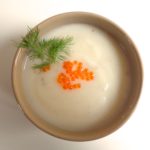 The humble cauliflower takes on elegance and class when transformed into crème de chou-fleur, a magnificent winter soup that is both light and packed with vitamins. It is essentially a purée of cauliflower with a spoonful of cream. Ground coriander seeds, lemon and dill enhance the flavor, while trout roe adds a bright touch — and more flavor. It makes a satisfying lunch dish and sparkles as a first course at dinnertime. Try it and see.
The humble cauliflower takes on elegance and class when transformed into crème de chou-fleur, a magnificent winter soup that is both light and packed with vitamins. It is essentially a purée of cauliflower with a spoonful of cream. Ground coriander seeds, lemon and dill enhance the flavor, while trout roe adds a bright touch — and more flavor. It makes a satisfying lunch dish and sparkles as a first course at dinnertime. Try it and see.

